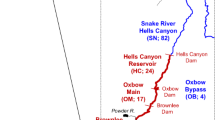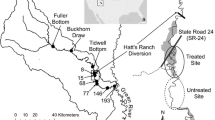Abstract
Tamarisk (Tamarix chinensis, Lour.) an artificially introduced tree, has become a most common species in many riparian vegetation communities along the rivers of the western United States. On the Salt and Gila rivers of central Arizona, the plant first appeared in the early 1890s, and by 1940 it grew in dense thickets that posed serious flood-control problems by substantially reducing the capacities of major channels. Since 1940 its distribution and density in central Arizona have fluctuated in response to combined natural processes and human management. Groundwater levels, channel waters, floods, irrigation return waters, sewage effluent, and sedimentation behind retention and diversion works are major control mechanisms on the growth of tamarisk; on a regional scale of analysis, groundwater levels are the most significant under present conditions.
Similar content being viewed by others
Literature cited
Aldridge, B. N. 1970. Floods of November 1965 to January 1966 in Gila River Basin, Arizona and New Mexico and adjacent basin in Arizona. U.S. Geological Survey Water-Supply Paper 1850-C. 176 pp.
Baum, B. R. 1967. Introduced and naturalized tamarisks in the United States and Canada.Baileya 15:19–25.
Brown, D. E., N. B. Carmeny, and R. M. Turner. 1977. Inventory of riparian habitates. Pages 10–13in Importance, Preservation, and Management of Riparian Habitat: A Symposium. US Forest Service, Fort Collins, 337 pp.
Brown, D. E., and C. H. Lowe. 1980. Biotic Communities of the Southwest. US Forest Service Technical Report RM-78, map.
Camp, Dresser, and McKee, Inc. 1980. Stage II Structural flood control alternatives: conceptual plans. Arizona Water Control Study, Phoenix, 39 pp.
Christensen, E. M. 1962. The rate of naturalization ofTamarisk in Utah.American Midland Naturalist 68:51–57.
Dietz, R. A. 1952. The evolution of a gravel bar.Missouri Botonical Garden Annals 39:250.
Emory, W. H. 1848. Notes of a military reconnaissance from Fort Levenworth in Missouri to San Diego in California. US Senate, 30th Congress, Executive Document 7. 194 pp.
Everitt, B. L. 1980. Ecology of saltceder—a plea for research.Environmental Geology 3:77–84.
Gary, H. L. 1965. Some site relations in three flood-plain communities in central Arizona.Journal of the Arizona Academy of Science 3:209–212.
Gatewood, J. S., T. W. Robinson, B. R. Colby, J. D. Hem, and L. C. Halpenny. 1950. Use of water by bottom-land vegetation in Lower Safford Valley, Arizona. U.S. Geological Survey Water Supply Paper 1103, 210 pp.
Graf, W. L. 1978. Fluvial adjustments to the spread of tamarisk in the Colorado Plateau Region.Geological Society of America Bulletin 89:1491–1501.
Graf, W. L. 1980. Riparian management: A flood control perspective.Journal of Soil and Water Conservation 35:158–161.
Griffin, J. S. 1943. A doctor comes to California. California Historical Society San Francisco. 243 pp.
Hadley, R. F. 1961. Influence of riparian vegetation on channel shape, Northeastern Arizona. US Geological Survey Professional Paper 424-c 30-31.
Harris, D. R. 1966. Recent plant invasions in the arid and semi-arid Southwest of the United States.Association of American Geographers Annals 56:408–422.
Hastings, J. R., R. M. Turner, and D. K. Warren. 1972. An atlas of some plant distributions in the Sonoran Desert. University of Arizona, Tucson. 255 pp.
Horton, J. S. 1962. Taxanomic notes onTamarix Pentandra in Arizona.The Southwestern Naturalist 7:22–28.
Horton, J. S. 1977. The development and perpetuation of the permanent Tamarisk type in the the phreatophyte zone of the Southwest. Pages 124–127in Importance, Preservation, and Management of Riparian Habitat: A Symposium. US Forest Service, Ft. Collins.
Horton, J. S. 1964. Notes on the introduction of deciduous tamarisk. U.S. Forest Service Research Note RM-16. 7 pp.
Horton, J. S. and C. J. Cambell. 1974. Management of phreatophyte and riparian vegetation from maximum multiple use values. US Forest Service Research Paper RM-117.23 pp.
Horton, J. S., F. C. Mounts, and J. M. Kraft. 1960. Seed germination and seeding establishment of phreatophyte species. U.S. Forest Service Research Paper RM-48 16 pp.
McClintock, E. 1951. Studies in California ornamental plants, 3. The tamarisks.Journal of the California Horticultural Society 12:76–83.
Merkel, D. L., and H. H. Hopkins, 1957. Life history of salt cedar (Tamarisk gallica L.).Transactions of the Kansas Academy of Science 60:360–369.
Péwé, T. L. 1978. Terraces of the lower Salt River Valley in relation to the late Cenozoic history of the Phoenix Basin, Arizona. Pages 1–45in Guidebook to the Geology of central Arizona. D. M. Burt and T. L. Péwé eds. Arizona Bureau of Geology and Mineral Technology, Tucson, Arizona, 176 pp.
Powell, J. W. 1893. Thirteenth Annual Report of the Geological Survey. US Government Printing Office, Washington, DC. 2 volumes, 1098 p.
Robinson, T. W. 1957. The phreatophte problem. Pages 1–11in Symposium on Phreatophytes. Phreatophyte Subcommittee of the Pacific Southwestern Inter-Agency Commission, Albuquerque, 39 pp.
Robinson, T. W. 1965. Introduction, spread, and aerial extent of saltcedar (Tamarix) in the western states. US Geological Survey Professional paper 491-A, 12 p.
Tomanek, G. W., and R. L. Ziegler. No Date. Ecological studies of salt cedar. Kansas College, Fort Hayes. 150 pp.
Turner, R. M. 1974. Quantitative and historical evidence of vegetation changes along the upper Gila River, Arizona. US Geological Survey Professional Paper 655-H. 20 pp.
US Army Corps of Engineers. 1979a. Flood damage report: February, 1979. US Army Corps of Engineers, Los Angeles, CA. 38 pp.
US Army Corps of Engineers. 1979b. Flood damage report: November, 1979. US Army Corps of Engineers, Los Angeles, CA. 41 pp.
US Department of Commerce. 1968. Climatic atlas of the United States. US Government Printing Office, Washington, DC. 80 pp.
Warren, D. K., and R. M. Turner. 1975. Saltcedar seed production, seedling establishment, and response to inundation.Journal of the Arizona Academy of Science 10:131–14.
Watts, J. G., D. R. Liesner, and D. L. Lindsey. 1977. Salt cedar—A potential target for biological control. New Mexico State University Agricultural Experiment Station Bulletin 650. 28 pp.
Author information
Authors and Affiliations
Rights and permissions
About this article
Cite this article
Graf, W.L. Tamarisk and river-channel management. Environmental Management 6, 283–296 (1982). https://doi.org/10.1007/BF01875060
Issue Date:
DOI: https://doi.org/10.1007/BF01875060




